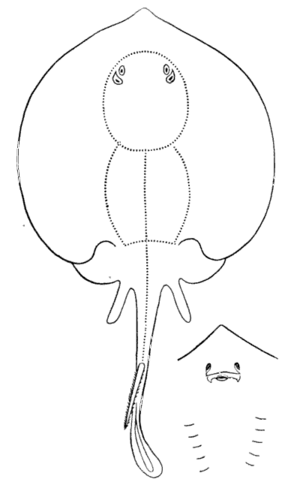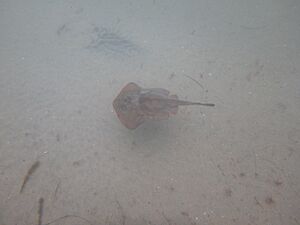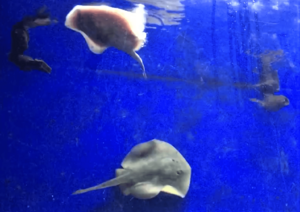Round stingray facts for kids
Quick facts for kids Round stingray |
|
|---|---|
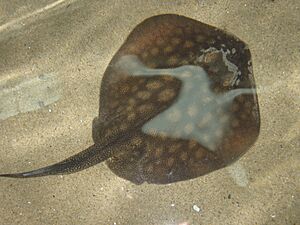 |
|
| Urobatis halleri | |
| Conservation status | |
| Scientific classification | |
| Genus: |
Urobatis
|
| Species: |
halleri
|
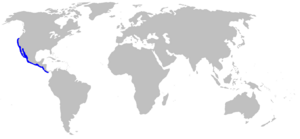 |
|
| Range of the round stingray | |
| Synonyms | |
|
Urolophus halleri Cooper, 1863 |
|
The round stingray (Urobatis halleri), also known as Haller's round ray or Little round stingray, is a type of fish found in the warm coastal waters of the northeastern Pacific Ocean. It's a small, common ray that mostly eats tiny creatures living on the seafloor. Along the beaches of southern California, these rays are known for stinging swimmers who accidentally step on them. The sting from its venomous spine can be very painful, but it's not deadly.
Contents
What's in a Name?
The scientific name, halleri, comes from the young son of Major Granville O. Haller of the United States Army. He was stung on his foot while walking in the waters of San Diego Bay.
Where Do They Live?
This stingray lives only in the eastern North Pacific Ocean. You can find them from Humboldt Bay in northern California all the way south to Panama. They are most common around southern California and the Baja Peninsula.
They like warm waters close to shore, usually less than 15 meters (about 50 feet) deep. However, they have been seen as deep as 91 meters (about 300 feet). These rays prefer soft places like mud or sand at the bottom of the ocean. They often hide in areas with lots of eelgrass, which helps them blend in. They can also be found near rocky reefs.
Round stingrays like water temperatures above 10°C (50°F). Adult rays can handle temperature changes better than young ones. They are most common in the coastal waters and bays of southern California from spring to fall. In winter, they move to deeper water where the temperature stays more steady. Sometimes, round stingrays gather near warm seawater released by power plants, as this can create conditions similar to their natural homes.
What Do They Look Like?
The round stingray has a body that is almost perfectly round. Its top side is usually brown or grayish-brown, with light yellow spots or patterns. Some rays are plain colored or even black. Their underside is white to yellowish.
They have a short, thick tail with a long, strong, saw-edged stinging spine. Their teeth are small and shaped like diamonds. Male rays have different teeth than females; the central teeth of males are pointy and curve inward. Males can grow up to 25 centimeters (10 inches) wide, while females can reach 31 centimeters (12 inches) wide.
The tail spine falls off and grows back over time. For most of the year, round stingrays have only one spine. But around July, small new spines start to appear. The number of rays with two spines increases until September or October. Then, the old spines fall off as new ones replace them. This process is usually finished by December.
Life and Habits
In the wild, round stingrays often live in separate groups based on their age and sex. Females tend to stay in water deeper than 14 meters (about 46 feet). Males and younger rays prefer shallower areas.
Young stingrays eat polychaete worms and small crabs that live on the seafloor. As they get older and bigger, their diet changes to include more bivalve molluscs, like clams. Round stingrays look for food during the day. They are most active when the water is warm in summer and fall. They use their bodies and mouths to dig large holes in the sand to find hidden prey. These digging actions are important for the environment because they also uncover food for smaller fish.
In the northern parts of their home range, round stingrays can be eaten by northern elephant seals and giant sea bass. Other large sharks also hunt them. Round stingrays can have many different parasites, which are tiny creatures that live on or inside them.
Reproduction and Life Cycle
Like other stingrays, the round stingray gives birth to live young. They usually have 1 to 6 babies at a time, with an average of 2 or 3. Bigger females tend to have more babies. The babies grow inside their mother for three months. When they are born, they are about 6–8 centimeters (2.4–3.1 inches) wide. Female rays can store sperm all year long.
In southern California, females move closer to shore to mate from April to June. The babies are then born between June and October. Further south, in the Gulf of California, females mate and give birth earlier, from late winter to spring. Some rays in this area even have a second group of babies later in the same year. After giving birth, the adult females return to deeper water, while the young rays stay in the shallower areas.
Female round stingrays create a small electric field near the spiracles (breathing holes) behind their eyes. This helps attract males. Males will bite this area, and this contact is needed for mating. Round stingrays grow about 3 centimeters (1.2 inches) per year until they become adults at around 31 months old. After that, their growth slows down.
Stingrays and People

Every year, hundreds of people swimming along the coast of southern California are accidentally stung by round stingrays. The sting is not deadly, but it can be very painful. A place called "Ray Bay" at the northern end of Seal Beach is especially known for these incidents because many young stingrays use it as a nursery.
Because of its small size and large tail spine, the round stingray is not usually caught for food. Sometimes, people fishing for fun or small fishing boats using gillnets catch them by accident and then throw them back. In Mexico, the tail is often cut off before the ray is thrown back, which likely causes many of them to die. Shrimp fishing boats also catch these rays by accident. Large groups of them can get tangled in the nets, which is annoying for the fishermen.
However, because there are so many round stingrays and they have babies often, they are not considered an endangered species. The IUCN Red List lists them as "Least Concern."
Keeping Them in Aquariums
Round stingrays are sometimes kept in aquariums. They can live well in captivity because they are relatively small and tough, as long as they have the right environment. An aquarium for a round stingray should have:
- Very few rocks or decorations.
- A bed of fine sand (not coarse sand or gravel).
- Good filters, because rays can be messy eaters.
- A secure lid or cover.
- Lots of swimming space (long, wide tanks are better than tall, skinny ones).
- Dim lighting.
- Water flow that moves in one direction, like a whirlpool, with no still spots.
- A total water flow rate of at least 10 times the tank's volume per hour.
- A water temperature between 12°C (54°F) and 22°C (72°F).
Also, any equipment sticking out in the tank, like overflows, should be covered with soft foam to prevent the ray from getting hurt. The oxygen levels in the water should be kept high. It's important to avoid stray electric currents and too much metal in the water. For example, copper should not be used as medicine for these rays.
You should feed them seven times a week, preferably with a feeding stick or long tongs, to make sure they eat what you intend. Young rays should eat soft foods like frozen Mysid shrimp, live Brine shrimp, and finely chopped shrimp. It's also important to add iodine to the water or give them special vitamins for rays. If they don't get enough iodine, they can develop a condition called Goitre.
Unhealthy stingrays might lose weight, look hollow in their belly, become slow, or have faded colors. It's best not to buy stingrays that look like this. When first put into a new tank, round stingrays might not eat for a while. Live foods like grass shrimp can help them start eating. After living in an aquarium for some time, they can become quite tame.
Some tankmates should be avoided, such as scorpionfish, Butterflyfish, large angelfish, Filefish, Triggerfish, Pufferfish, Porcupinefish, certain sharks, large Crabs, Hermit crabs, and Sea anemones. These can bother the ray or even harm it. Round stingrays might also rest on or knock over Corals, which could sting the ray or damage the coral. So, they are not a good choice for a Reef aquarium. When they are young, they can also be eaten by Frogfish and large Groupers.
Round stingrays are often collected from California's southern coast, which is why they are sometimes called "California stingrays" in the aquarium world. They also go by other names like "Spotted stingray," "Cortez ray," and "Dwarf Cortez ray." When sold as "Cortez ray" or "Dwarf Cortez ray," they are often confused with the very similar Cortez round stingray (Urobatis maculatus). You can tell the two apart because the Round stingray does not have the black spots that the Cortez round stingray has on either side of its body.
Round stingrays are also kept in some Public aquariums, like the Aquarium of the Pacific in Long Beach, California. There, their tail spines are clipped regularly so that visitors can safely touch them until the spines grow back.
Gallery
-
A round stingray in the Reiman Aquarium at Discovery World.
-
A round stingray caught in San Diego Bay, CA.
-
A round stingray resting in the Monterey Bay Aquarium.
-
An active round stingray in the Monterey Bay Aquarium.
-
A round stingray lifting off the bottom at the Aquarium of the Pacific.



